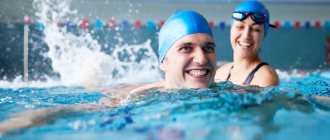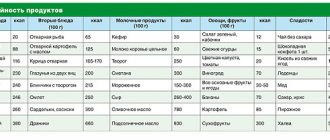Swimming can be a great workout for burning calories and losing weight. For every kilogram of your body weight, swimming burns between 0.1 and 0.14 calories per minute. If you weigh around 150 pounds, you can expect to burn more than 200 calories in 30 minutes. This is a fairly serious figure when compared even with cycling or running at an average pace, and certainly better than walking. Remember that certain swimming strokes, such as butterfly and breaststroke, burn more calories, so choose wisely.
- Swimming burns more calories
- Swimming is a great full body workout
- You burn 446 calories in an hour of swimming.
- Swim for just 30 minutes a few days a week
- The backstroke burns 298 calories and the butterfly burns 409 calories in 30 minutes.
- Swim Mixed to Burn More Calories
- Let's calculate how many calories are burned if you swim 1000 meters Let's figure it out: how long are you actually swimming?
Swimming burns more calories
Previously, we talked about whether it is possible to lose weight by swimming in the pool, this time we will talk about the effectiveness of this type of training for burning in terms of calorie expenditure.
- You burn 446 calories in an hour of swimming.
- Swim for just 30 minutes a few days a week
- Swimming butterfly burns 409 calories in 30 minutes
- Swim Mixed to Burn More Calories
What if I told you that you can burn 400 or all 500 calories without breaking a sweat? Yes, yes, I'm talking about how many calories are lost when swimming! You can burn several hundred calories in just half an hour in the pool - and even more if you choose a more challenging swimming style or increase your pace. Once you learn about the calorie burn of swimming, you may never want to go back to the sweat-soaked land technique again!
There are many reasons to add this full-body workout to your fitness regimen. The time spent in the pool can be used with maximum efficiency. Read on and find out exactly how.
Factors affecting calorie expenditure
When swimming, a huge amount of calories is lost, but energy consumption directly depends on gender, swimming style, regularity and intensity of training, as well as the weight of the swimmer. If a water sport is chosen solely to improve health and relieve stress, it is necessary to select a comfortable mode and regularity of training. Even minimal exercise in water, reminiscent of unobtrusive childish floundering, invariably leads to a loss of calories and a slender, toned figure.
If swimming is chosen as a way to lose weight and form sculpted muscles, you need to thoroughly understand which style burns a certain amount of calories, what pace and duration of training lead to the greatest waste of energy. In order to get the maximum benefit from water exercise, it is better to contact a professional trainer who will calculate the correct regime for visiting the pool and the intensity of exercise.
Floor
At the same intensity and pace of training, men spend more kcal during swimming than women. This is most often due to the greater body weight and accelerated metabolism of the male body.
Swimming style
It is no secret that calorie consumption completely depends on the style of swimming; the higher the load for a certain type, the faster energy is consumed and fat is burned. In a pool or open water, you can swim like a dog, just having fun, or cut kilometers with the backstroke or butterfly. Light, casual swimming, despite the lowest energy consumption of 150-200 kcal per hour, will lead to minimal calorie burning and toning of the muscles of the back, hips and abdomen. When training breaststroke in the pool, the body burns up to 300-500 kilocalories per hour of swimming. Butterfly and crawl are the most energy-consuming swimming styles, the consumption of which can be up to 700 kcal/hour. Such intense training strengthens the body as much as possible, forms sculpted muscles and speeds up metabolism.
Breaststroke
Breaststroke is the slowest of all swimming strokes. Breaststroke swimming consists of synchronized strokes of the arms and pushes of the legs while exhaling into the water. With a slow pace and correct technique, a 45-minute workout can burn about 250 kcal; increasing the pace results in energy consumption of up to 350-400 kcal, depending on the weight of the swimmer. This style is very suitable for beginners or a comfortable workout for fun.
Crawl on chest
Front crawl is a freestyle swimming style that involves alternating arm strokes and scissor-like movements of the legs while lying on the chest. Despite the fact that this type is the fastest and has a fairly complex technique, it is also recommended for beginners and people who want to improve their health in the pool and tighten their figure. At a low pace and heart rate of 130 beats per minute, you can lose 200-250 kcal per hour of training; if you increase the pace and heart rate to 150 beats/min, energy consumption will increase to 500 kcal.
Back crawl
The technique of the back crawl is similar to the front crawl when lying on your back. With this style, it is necessary to perform alternating hand strokes and alternating kicks in the manner of scissors. The back crawl is chosen by many beginning athletes due to the fact that the face is constantly out of the water. Backstroke swimming is faster in speed than breaststroke, which results in greater energy consumption with a fairly comfortable load. If you follow the technique correctly, you can burn about 300-400 kcal in an hour of intense training.
Butterfly
Butterfly is the most difficult and energy-consuming swimming style with heavy equipment, which is only suitable for professionals. When swimming classic butterfly, the swimmer makes a powerful stroke with his arms, lifting his body above the water, while his legs make a push like breaststroke. In the high-speed dolphin butterfly, the athlete’s legs perform wave-like movements from the hip, similar to a dolphin’s tail. In terms of speed, this style is in second place after the front crawl. An hour of butterfly training leads to a loss of 700-800 kcal, but it is advisable to master this style with a coach to develop the correct stroke technique.
Training time (30 minutes, 40 minutes, 45 minutes and 1 hour)
The time of training determines the amount of energy expended. Any water exercise has a beneficial effect on metabolism and health promotion, but calorie consumption begins only after 20 minutes of intense training, so it makes no sense to spend less time in the pool. In 30 minutes of water sports, depending on the chosen style, you can lose about 100-300 kcal, in 40 minutes the number of kilocalories increases to 150-350.
When swimming in the pool for 45 minutes at an intense pace, 400-500 kilocalories are burned; in 1 hour of training in butterfly or backstroke you can lose up to 700-800 kcal. Obviously, to build muscle endurance and lose weight, training should be at least an hour, and it is better to swim for 2-3 hours. Regularity is also important. Professional Polovtsy train daily for 4-6 hours a day; amateurs are recommended to visit the pool 2-3 times a week for 1-2 hours.
Table: Average number of calories burned during 1 hour training in the pool, depending on style and gender
| Swimming style | Calorie consumption | |
| Man | Woman | |
| Breaststroke | 700 | 500 |
| Back crawl | 720 | 600 |
| Crawl on chest | 700 | 500 |
| Butterfly | 780 | 500 |
Training intensity
The faster the workout pace, the more calories swimming burns. Even with the same style and a leisurely rhythm, 1.5-2 times less energy is spent than working with the same type of water sport at full strength. Breaststroke is the easiest way to swim, but this style requires less energy. Although an hour-long workout with one breaststroke consumes up to 300 kcal and, with regular visits to the pool, invariably leads to a toned stomach and legs. The most energy-consuming style is butterfly, which is quite difficult to swim, but it burns up to 700-800 kilocalories per hour and creates sculpted muscles. With any style of swimming, it is important to follow the technique, otherwise training can lead to muscle pathologies.
Own weight
Calorie consumption directly depends on the weight of the athlete; the more a person weighs, the more intense the calorie burning occurs. With a body weight of up to 70 kg for women and up to 120 kg for men, about 10 kcal per 1 kg of weight is burned per hour of training at a fast pace. For example, a man weighing 80 kg can consume 700-800 kcal, while a woman weighing 60 kg can consume 500-600 kcal. If you are overweight, these figures increase significantly. The amount of energy spent will depend not only on a person’s body weight, but also on time, regularity and pace of training, swimming style and water temperature.
Table: Average number of calories burned during a 1-hour workout in the pool, depending on style, gender and weight
| Swimming intensity | Calorie consumption with a weight of 50 kg | Calorie consumption with a weight of 60 kg | Calorie consumption with a weight of 70 kg | Calorie consumption with a weight of 80 kg | Calorie consumption with a weight of 90 kg | |||||
| Man | Woman | Man | Woman | Man | Woman | Man | Woman | Man | Woman | |
| Swimming without load (0.5 km/h) | 175 | 125 | 210 | 150 | 245 | 175 | 280 | 200 | 315 | 225 |
| Slow breaststroke | 327 | 233 | 392 | 280 | 460 | 324 | 526 | 370 | 592 | 416 |
| Intensive swimming (2.5 km/h) | 383 | 273 | 460 | 328 | 540 | 380 | 615 | 437 | 694 | 490 |
| Slow crawl swimming | 385 | 315 | 462 | 378 | 535 | 445 | 615 | 505 | 685 | 575 |
| Swimming fast crawl | 476 | 340 | 573 | 405 | 665 | 475 | 761 | 541 | 802 | 662 |
Fold type
People with different body types, with the same intensity of training, lose calories in completely different ways, this is due to different thickness of the fat layer and metabolic rate. Thin athletes with long arms and legs, an angular appearance and a lack of subcutaneous fat burn calories the fastest. Most often, such people do not need to lose weight, but to gain muscle mass.
A person with developed muscles, broad shoulders and an average fat layer, who has a good metabolism, can lose up to 500-800 kcal with an intense hour-long workout. An athlete with massive body fat, excess weight and a low metabolism will burn calories much more slowly.
Water temperature
An important factor on which the number of calories burned depends is the temperature of the water in the pool, sea or any other open body of water. The colder the water, the more energy the body spends during training to warm itself. But you shouldn’t be overzealous and freeze in cold water, otherwise you can get hypothermia and a bunch of diseases of the lungs, kidneys and reproductive organs. During training, the athlete should be comfortable in the water; to warm up, you can increase the pace or briefly change a calm swimming style to a more energy-consuming one.
Swimming is a great full body workout
Swimming is a whole exercise program rolled into one, and it's good for you for a variety of reasons.
- Safe Cardio: Cardio is very important in a training program to raise your heart rate. Swimming helps you do this without stressing your joints the way vigorous aerobics or dance-based exercises do.
- Strength Training: In addition to strengthening your cardiovascular system, swimming tones your muscles and helps build strength just like weight training.
- Increased stamina: It also helps improve stamina.
- Increased Lung Capacity: As your endurance improves, your lung capacity also increases.
- Full Body Workout: A full body workout in the truest sense of the word, swimming works almost every muscle in the body, leaving you invigorated and energized.
- Reduces the risk of diabetes, heart disease and stroke: Regular swimming can reduce the risk of developing chronic diseases such as type 2 diabetes, heart disease and even stroke.
- Better load distribution: The New York Times published an article stating that swimmers' bodies are better able to handle stress than runners' bodies. Unlike runners, whose performance decreases the longer the distance they run, swimmers maintain a steady pace even over long distances. In fact, the statistician and swimmer quoted in this article found that competitive swimmers burn 25 percent more calories than runners for the same amount of training time.
- Weight Loss: If that's not enough to get you thinking about swimming, how about the faster weight loss and mood boost that swimming provides?
Swimming technique for weight loss
Proper swimming requires a minimum speed of 2.5 km/h: in 10 minutes you need to cover up to 7-8 lanes in a 50-meter-long pool. Unlike classes in open water, they are more effective in a pool due to the possibility of working with an instructor. He will professionally select exercises, style and teach the correct swimming technique. This will speed up the weight loss process.
In order for swimming to bring maximum benefits to those losing weight, you should listen to some tips:
- Do a short warm-up first, about 10 minutes. This will help the muscles warm up.
- Learn to breathe correctly in the process.
- Exercise 2-3 times a week. For beginner swimmers, training time should not exceed 30 minutes, with a gradual increase to 45 or more.
- Preference is given to the crawl style.
- Whenever possible, combine different types of styles to target all muscle groups. For a change, women are recommended to sometimes resort to water aerobics - a system of water gymnastics aimed at correcting the figure and strengthening the muscle frame.
- You can use interval training, which usually lasts 15 minutes.
- After physical activity, you should not eat for the first half hour.
If you want to get rid of fat folds on the sides, then swimming on your back is recommended. Butterfly is more suitable for strengthening the abs, legs and arms.
Training techniques for weight loss:
| Swimming style | Description |
| Crawl | Performed on the stomach, with alternating hand strokes |
| Butterfly | It consists of moving on the stomach, but swinging the arms simultaneously. The pelvis and legs move in waves |
| Breaststroke | The most difficult style, giving maximum load on the muscular area of the chest and arms. This technique does not imply a fast pace, as it is difficult to perform. The principle is as follows: while on the chest, move both arms and legs synchronously |
Interval training
Regardless of style, interval training is more effective at helping you lose weight. The method is based on alternating efforts - from maximum to minimum. Even 2 days after such an exercise, the weight will invariably come off, since the body does not have time to readjust and continues to work in an active mode.
Interval training usually takes 10-15 minutes. This is done as follows:
- The first 30 seconds are spent swimming with full effort, preferably butterfly.
- The next 15 seconds switch to breaststroke at a relaxed pace.
This amounts to one full interval, which must be done from 8 to 10 for beginners and 15 for professionals. Gradually, with the growth of physical capabilities, the rest is reduced to 10 seconds, and the “jerk” is reduced to 40 seconds.
Useful tips:
- Start with a warm-up for 5–10 minutes, during which you alternate styles and tempos of movement.
- Within one workout, adhere to the initially selected regime: 30/15 or 40/10.
- It is unacceptable to rest less than expected and work more.
- Evidence of effectiveness is the loss of strength at intervals 5–7. If this happens before, it is recommended to reduce the load next time.
- After finishing the lesson, swim at a relaxed pace for about 5 minutes.
It is important to accurately maintain time intervals and control your pulse. Regardless of the degree of fatigue, nothing can be changed. For effective weight loss, the heart rate should be within 140 beats per minute. To track these parameters, you can use a fitness watch or special bracelets.
You burn 446 calories in an hour of swimming.
Looking to add swimming to your fitness regime? First, figure out how many calories you burn in an hour or even a short 20-minute swim.
Swimming for 30 minutes burns about 223 calories for the average person weighing about 70 kilograms. Thus, in an hour you will burn 446 calories. This is comparable to a very fast dance or walking over rough terrain. And this is only for swimming at an average pace. Switch to butterfly or breaststroke and those numbers increase even more.
Swimming vs. Walking: Walking at 5.5 km/h will burn 149 calories (versus 223 calories for swimming in the same amount of time). Even if you accelerate to 7 km/h, swimming will still remain ahead - in 30 minutes of such walking you will burn just over 180 calories.
Calorie consumption when swimming breaststroke
The higher a person’s mass, the harder it is for him to float on the water. Since a person with a higher weight puts in more effort when swimming, their energy expenditure is higher than that of a person with a lower weight.
The breaststroke swimming style is more suitable for beginners. With a simple technique, breaststroke is highly dynamic and requires increased coordination. Depending on the weight of the swimmer at low intensity (90-135 heart rate/min), energy expenditure will range from 280 to 450 kcal per 1 hour of continuous training.
The high intensity of the load when swimming breaststroke (over 155 heart rate/min) allows you to burn 600 kcal or more.
Swim for just 30 minutes a few days a week
You don't need to force yourself to swim for 2 hours per session just to burn more calories. Swimming for just 30 minutes a few days a week will help you reach your physical activity goals. The World Health Organization recommends 150 minutes of moderate-to-vigorous physical activity for adults aged 18 to 64 - and swimming does a great job of achieving this. The great thing about it is that due to its softness, it is suitable even for older people.
Swimming: Burn calories in the pool in 30-45 minutes, for an hour
How many calories are burned when squatting?
In order to achieve results in weight loss, you need to adhere to regularity in training and perform it well. To do this you need:
- While in the water, keep your body in constant tension, which burns calories. Of course, it is necessary to take breaks, but not long and not often.
- Change swimming styles, move from one to another, for example, first breaststroke, then backstroke, then change style again.
- Eat right, you need to eat 1.5 hours before training and refrain from eating after training for an hour. Nutrition must replenish the body's energy expenditure, it must be complete and balanced. You need to come to training well-fed. You need to exclude from your diet so-called appetite stimulants, such as ketchup, mustard, horseradish, seasonings, etc.
- Breathe correctly. Inhale through your mouth and exhale through your nose.
- Swim regularly, for 30-40 minutes, 2-3 times a week, and after a couple of months you can see results.
- Make sure to maintain a high body position on the water, because as you go deeper, the resistance becomes greater and the technique breaks down.
- It is recommended to swim with goggles, as without them an effective workout will not be possible. You need to choose glasses that fit tightly to your face.
The backstroke burns 298 calories and the butterfly burns 409 calories in 30 minutes.
Everyone has their own swimming style. Which leads to the question, how many calories does breaststroke (or any other swimming stroke of your choice) burn compared to crawl or freestyle?
Want to calculate the number of calories you burn swimming freestyle compared to breaststroke or other swimming events? Take a look at this excerpt from the Harvard Health Foundation report.
The number of calories burned per 30-minute workout for an adult weighing 70 kilograms:
| Swimming style | Number of calories |
| Swimming at a medium pace | 223 |
| Back crawl | 298 |
| Intense distance swims | 372 |
| Butterfly | 409 |
| Crawl | 409 |
Crawl, breaststroke or butterfly?
First of all, it should be noted that in order to effectively burn calories, in any case, you should swim in the correct technique, with your head in the water .
This is also important for your health, I wrote about it here and here.
If you go to the pool to lose weight, but have doubts about your swimming technique, take at least a few training sessions from a trainer .
As for which style to choose for weight loss, it is worth noting the following:
- The crawl and breaststroke are not very different from each other in terms of calorie burning.. If you are more of a breaststroke swimmer in terms of technique, but are not so good with the freestyle, then faster and more correct breaststroke swimming may well give better results in terms of energy consumption.
Breaststroke - Not only does it take 30 minutes to swim the butterfly stroke, but even for at least 10 minutes continuously, few people can swim. This is a physically very challenging style and is suitable for professionals and advanced swimmers.
In this regard, you should not count on the fact that you will be able to swim continuously for an hour or at least half an hour in the butterfly stroke and thereby burn a lot of calories - this is physically impossible for most pool visitors. On the other hand, butterfly goes well with other styles : you can swim along the pool path in one direction with butterfly, return back on your back, or (if you have enough strength) with crawl or breaststroke. Here we also come to the next point. - As I have written more than once in articles on this site, if you exercise in the pool for health, strengthening muscles, ligaments, and developing endurance, then it is most optimal to combine all swimming styles during training (focusing on one style makes sense when developing technique or when preparing for competitions).
This is due to the fact that different muscle groups are involved in different styles (see separate articles about working muscles in crawl, breaststroke, butterfly, backstroke).
By combining styles, you fully work out your body - this is a unique feature of swimming, not typical of most other sports.At competitions there is a separate discipline that combines all styles - medley swimming. However, it is usually difficult for a physically unprepared swimmer to swim more than 2-3 complexes in a row (primarily due to the presence of butterfly in their composition). It is more realistic to swim freestyle and breaststroke separately, and combine butterfly (if desired and able) with, for example, backstroke – as indicated in point 2 above.
Swim Mixed to Burn More Calories
As with dryland training, the best results come from mixing styles to tone your muscles and help you burn more calories. Swimming, as a land-based interval workout, can be easily customized to suit your needs, using a variety of styles at different speeds to optimize your time in the pool. One workout program developed by Fitness Magazine aims to burn 270 calories in just 22 minutes and 40 laps by combining exercises such as freestyle swimming, backstroke, paddleboarding, fast and slow laps.
Calorie consumption when swimming butterfly
Since butterfly is one of the most energetic swimming styles, it is the most effective for losing weight. However, for those new to swimming, the technique of this style will seem difficult. If you have mastered the crawl and breaststroke, feel free to start learning the butterfly technique in your training plan. The high pace of swimming with this style allows you to get rid of 550-880 extra kcal in one hour of swimming in the pool. This figure is close to that of strength fitness.
At a slow pace and low intensity of exercise, calorie losses average 380-760 kcal.
If you visit the pool for the purpose of losing weight, focus not on the time it takes you to swim 100 m, but on your well-being and the time spent in the water.
Calculate how many calories are burned if you swim 1000 meters
As a rule, the length of a regular swimming pool is 25 meters in the short part and 50 meters in the long part. Olympic training pools are typically 50 meters long. Let's take a 50-meter circle as a basis.
Let's figure it out: how long are you actually swimming?
- To swim 1000 meters in a long pool, you need to do 20 laps
- To swim 1000 meters in a short pool, you need to do 40 laps
- To swim 1 mile in a long pool you need to do 32 laps
- To swim 1 mile in a short pool, you need to do 64 laps
Number of calories burned
So how many calories will you burn if you swim 20 laps? Remember that this depends on what stroke you are using and how fast you are swimming. In other words, to calculate the number of calories burned in 1000 meters or 20 laps, track the time it took you. Now look at the value in the table in the “number of calories” column next to your chosen swimming style, and you will have the required figure.
- Number of calories burned in X laps = X * time spent on 1 lap (in minutes) * Number of calories burned per minute for the chosen swimming style
To figure out how many calories you'll burn swimming a mile or half a mile, do the same, assuming 32 laps equals a mile in an Olympic-size pool.
- Calories burned in 1 mile = Calories burned in 32 laps = 32 * time taken for 1 lap (minutes) * Calories burned per minute for selected swimming style











